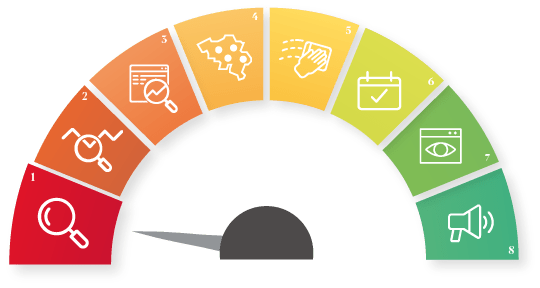
The impact of the coronavirus crisis is set to reverberate for quite some time, also affecting companies’ resilience in the long term. In an initial phase a lack of liquidity arises, affecting resources for immediately meeting ongoing payment obligations as a whole. For many sectors, this is now already a reality. In a second phase, companies will have to refinance their activity and rely on capital made available by third parties. In that phase, companies are confronted with solvency issues.
Given that only the 2018 annual account is available and we are unaware of the very latest liquid-asset situation, on the one hand we analyse the proportion between customer receivables – amounts a company is owed by customers or other partners – and equity, and on the other hand the proportion between the customer receivables and the gross margin – the difference between sales and costs of products, services and miscellaneous goods. If too much money is immobilised in customer receivables (outside crisis context), once the company’s trade cycle comes to a halt and the customers start paying later, it will no longer have money to finance everything else: general expenses, credit-line redemptions and suppliers.
The longer the crisis, the heavier the losses. The heavier the losses, the greater the impact on equity. The heavier the impact on equity, the more difficult it is to obtain credit and to refinance the trade cycle.
In order to calculate the impact on the credit score, we calculate in various stages how many weeks a company can lose gross margin before reaching the sensitive threshold of insufficient solvency. We have set those thresholds at 25%,15% and 0%. The basic calculation will continue to 16 weeks, but ceases sector by sector as soon as the lockdown is lifted.
Trends Business Information allows you to enhance your customer and supplier base with an adjusted resilience indicator and an optimised credit score. You send a file with CBE numbers, and we complete this. That way, you have an overview of the companies requiring support in order to survive this period. A new calculation will always be performed once new balance sheets are published. Given that the crisis affects the first (and second) quarter of 2020, it is extremely important to have a picture of those most recent figures so that the reality is reflected as best as possible.
Get in touch with us at info@tbi.be to enhance your customer and supplier base with our resilience score.
You provide us with an Excel or CSV file with enterprise numbers, and we will complete this for you. That way, you gain a picture of the extent to which companies require support in order to survive this period.
Any questions?
Trends Business Information is ready to support you
Haven’t you found what you were looking for? No problem, our team of motivated employees behind the scenes will do everything in its power to help you.

